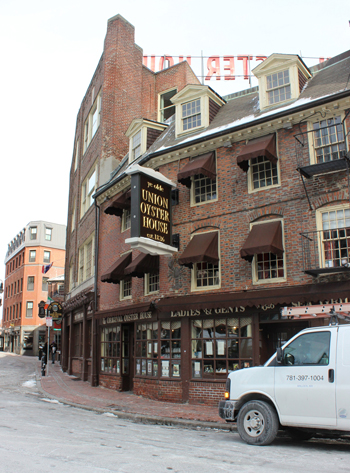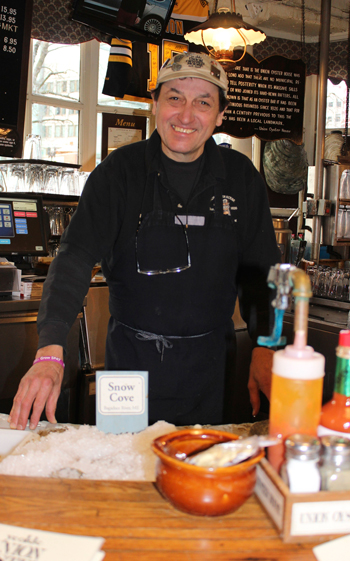Union Oyster House

The Union Oyster House, Boston, MA. Built sometime before 1765, the building has been home to America’s oldest restaurant since 1826. A variety of New England oysters are served, many of them from Maine. Fishermen’s Voice photo
America’s oldest restaurant remains famous in part for its signature offering—the American oyster. The Union Oyster House in Boston, where Daniel Webster regularly lingered over platters of oysters in the 1850s, opened in 1826 and still features a variety of New England oysters. At least four Maine varieties were on the menu in January this year. They included Wawenauk Oysters, Damariscotta; Wiley Point Oysters, Damariscotta River; Snowe Cove Oysters, Brookfield and Pemaquid Oysters.
The Union Oyster House is located in a Pre-Revolutionary-War-era 1700s brick building situated among a cluster of similarly old buildings around which wind the original narrow cobblestone streets of America’s oldest city. The original 1826 interior with its half-circle oyster bar and booths in their original positions is just one area in a warren of dining areas on the restaurant’s three floors.
At the oyster bar, Anton Christen is the resident oyster expert. Anton shucks oysters to order for customers seated at the bar while he expounds on the differences and fine points among regional oysters. One he notes is the Pemaquid Oyster, which at times the restaurant has sold 600 to 1,000 per night, he said. He and co-oyster bar expert and shucker Jimmy Red attend oyster festivals around New England in the warmer months. They of course sample the oysters, but they also compete in oyster shucking contests. Red’s stated record is a dozen oysters shucked in 1.4 minutes.
The Maine Oyster Festival in Boothbay Harbor is one both Anton and Jimmy praised. The Milford Oyster Festival in Milford, Conn., is another that last year served 37,000 oysters in seven hours, said Anton.

Union Oyster House oyster expert Anton Christen over a bin of Maine oysters. The half circle 1826 oyster bar features a variety of iced-down oysters. They are shucked and served to customers seated at the bar. In front of Anton is a tray of Maine’s Snow Cove oysters. Fishermen’s Voice photo
The exact date the Union Oyster House building was constructed is not known. Union Street was laid out in 1636 and the building is known to have had a prominent place in the city for at least 250 years. The early stirrings of the American Revolution reached the upper (fourth) floor when in 1771 Isaiah Thomas published a newspaper “The Massachusetts Spy,” believed to have been the oldest newspaper in the United States. In 1775 the building was a silk and dry goods store when it became the headquarters for the first paymaster of the Continental Army.
In 1742 the waterfront was out the back door where ships unloaded goods for this commercial district just a block from the British-built old statehouse. That waterfront was the source of oysters harvested in Boston Harbor and the nearby Mystic River. Boston’s famously filled-in waterfront infamously spelled the end of oyster reefs that were so close to the half-circle oyster bar.
Early 1800s America is said to have experienced an oyster craze. Oysters were being served in many places in most coastal cities and towns. As late as the 1930s New York Harbor was the premier supplier of oysters to the European markets. It was not the appetite for these prolific sea animals that led to their near-catastrophic decline, but the careless disregard of consumers for the water quality these delicacies depended on. The oyster is a filter feeder. A single oyster is capable of effectively cleaning 50 gallons of water a day, but there are limits to what it can withstand. Oyster reefs were also blasted to make way for the passage of larger ships in the estuaries that formed the bays.
Oysters are now experiencing a new interest in their survival and proliferation. Wild habitats are being restored for the development of beds for harvest and reefs for the storm surge protection they formerly provided. Oyster cultivation operations are being started in salt ponds and on lease sites along the New England coast. Wellfleet Harbor on Cape Cod has seen a recent dramatic restoration. Historically important habitat areas for oysters along the Damariscotta River in Maine have been restored. In other parts of Maine the growing ranks of oyster habitat restorers and cultivators are finding ready markets for their product.
In Maine, a decline in production was followed by a rebound. The very productive Damariscotta River area has been eclipsed in recent years by the total production of other oyster-producing areas in Maine. The total value in 2012 based on DMR reporting data was about $1.6 million. Awareness of and demand for Maine oysters has since risen.
Changing expectations for better habitat management and recognition of the interrelated dependence of species is likely to support greater oyster production. The oyster’s positive effects on declining water quality and the potential for helping re-diversify commercial fisheries will also likely impact growth of this resource.
